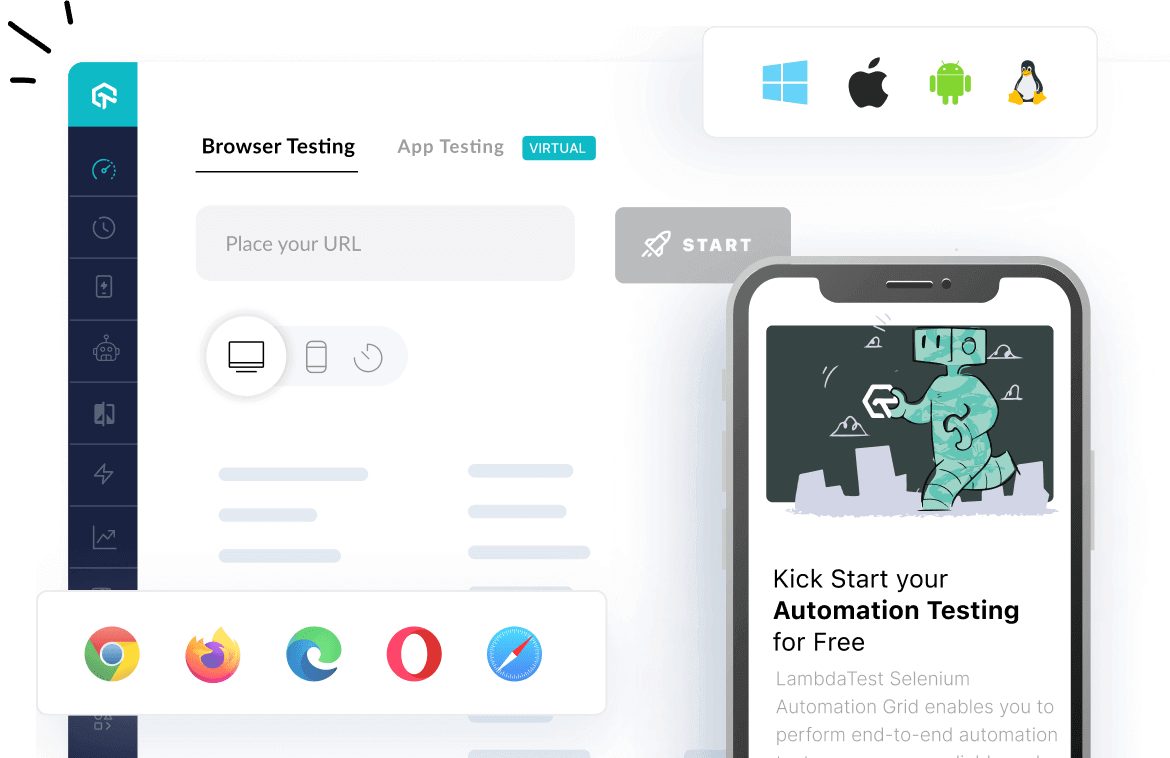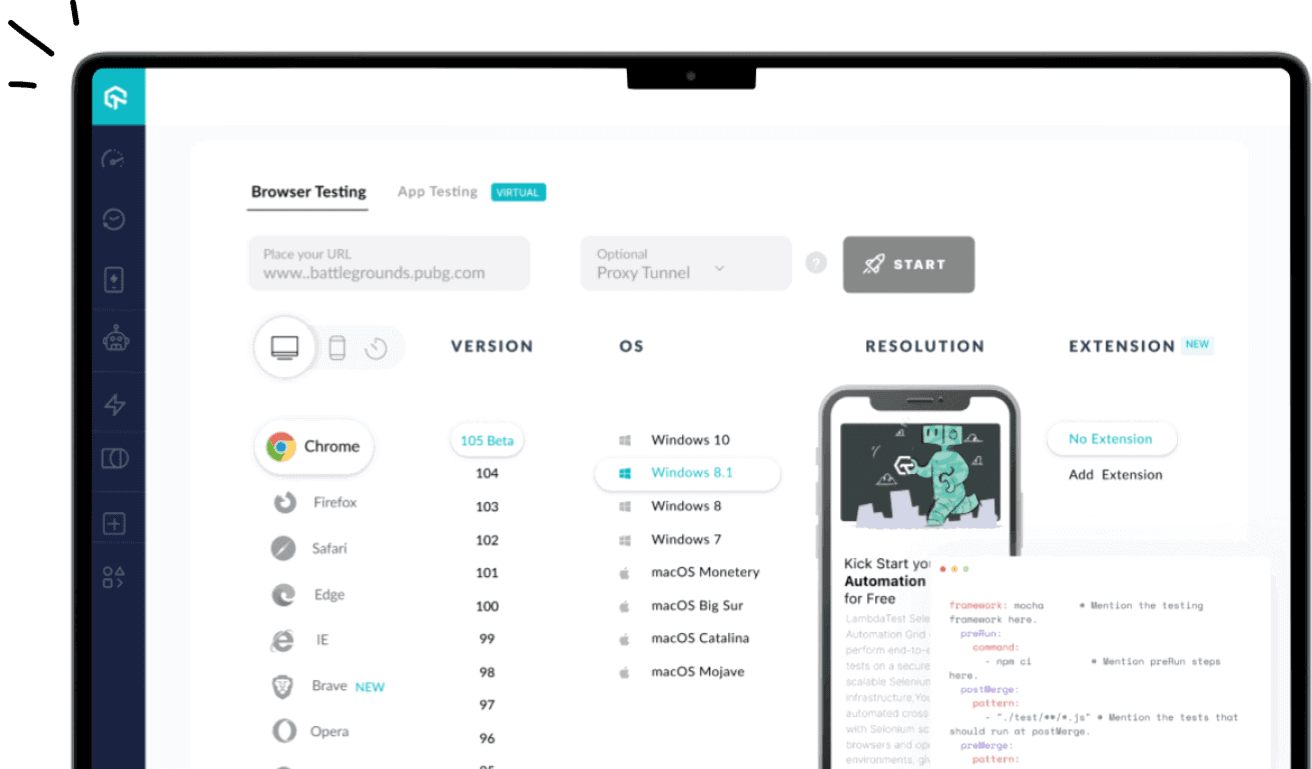- Testing Basics
- Home
- /
- Learning Hub
- /
- Top 35 Pytest Interview Questions
- -
- May 02 2023
35 Pytest Interview Questions To Prepare
Boost your testing skills with Pytest interview questions. Beginner, intermediate, and advanced levels covered. Prepare and excel in your interviews.!
Total Chapters (25)
Chapter 19 : Pytest Interview Questions
OVERVIEW
Pytest is a popular testing framework for Python that has gained widespread use and popularity in recent years. According to GitHub , Pytest has over 10,000 stars, 8,00,000+ users and 700+ contributors as of April 2023. And having knowledge of Pytest can be an advantage in the job market. Many companies use Pytest for testing their Python code, so being familiar with Pytest and its features can make you a more competitive candidate. By practicing common Pytest interview questions and having a solid understanding of the framework, you'll be better prepared to showcase your skills during the interview process.
This article has a list of the top 35 Pytest interview questions that are frequently asked at the beginning, intermediate, and advanced skill levels. These inquiries address a range of Pytest topics, including the fundamental syntax, fixtures, parametrization, markers, and plugins. You may assess how well you understand Pytest by working through these questions and determining where you need to learn more.
Pytest Interview Questions Sheet
Note : We have compiled all the pytest interview questions in a sheet. Feel free to comment on it. Check it out now!!
Pytest Interview Questions for Beginners Level
These Pytest interview questions are designed to help you learn the basics of Pytest, such as how to use it, how to install it, how to make a basic test function, and how to use it to run tests.
1. What is Pytest, and why do we use it?
Pytest is a well-liked Python testing framework that makes it easier for programmers to create and execute unit tests. It provides better reporting, a clearer syntax, and is simpler to discover tests than the built-in unittest module. Pytest is used to test code before it is put into production to make sure it works as planned and to identify any errors or weaknesses.
2. What is a test fixture in Pytest?
A test fixture performs the setup and breakdown tasks required for a test. Fixtures are reusable resources that can be provided in Pytest and are defined using the @pytest.fixture decorator.
3. How do you run a test with Pytest?
To run a test with Pytest, use the Pytest command followed by the name of the test file or directory. For example, to run all tests in the current directory, use Pytest. To run a specific test, use Pytest path/to/test_file.py::test_name.
4. What is an assertion in Pytest, and how do you use it?
A statement that tests if a condition is true is called an assertion. Using the assert keyword and the condition to be checked, assertions are made in Pytest. As an illustration, use the statement assert my_function() == expected_value to determine whether a function's output equals a particular value.
5. What is the difference between assert and assert not in Pytest?
assert is used to check whether a condition is true, while assert not is used to check whether a condition is false. For example, assert my_function() == expected_valuechecks whether my_function() returns the expected value, while assert not my_function() checks whether my_function() returns a value that is not true.
6. What is the Pytest.ini file, and what is its purpose?
You can modify how Pytest behaves by using the pytest.ini configuration file. It can be used to configure settings for things like test discovery, test execution, and reporting.
7. How do you write a test case in Pytest?
In order to create a test case in Pytest, define a function that begins with test_ and use the assert keyword to verify that the function being tested produces the desired outcome. For example:
def test_addition():
assert 1 + 1 == 2
8. What is a test suite in Pytest?
A test suite in Pytest is a collection of test functions that are run together. Test suites are created by organizing test functions into test files or directories.
9. How do you skip a test in Pytest?
Use the pytest.skip() function inside the test function to skip a test in Pytest. For example:
def test_functionality():
if not some_condition:
pytest.skip("Some condition not met")
assert my_function() == expected_value
10. How do you parametrize a test in Pytest?
To parametrize a test in Pytest, use the @pytest.mark.parametrize decorator. For example:
@pytest.mark.parametrize("input, expected", [(1, 2), (2, 3), (3, 4)])
def test_increment(input, expected):
assert input + 1 == expected
Pytest Interview Questions for Intermediate Level
This section's Pytest interview questions deal with more complicated Pytest topics like fixtures, parametrization, markers, and plugins. They make an effort to test a deeper understanding of Pytest and presumptively understand it.
11. What is the purpose of the conftest.py file in Pytest?
The conftest.py file is used to specify fixtures and other configuration options that apply to a complete test suite or a particular directory. It is automatically found by Pytest and can be used to transfer fixtures and settings between test files.
12. What is monkey patching in Pytest, and how do you use it?
In Pytest, monkey patching is the practice of swapping out a function or variable for one that is particular to a given test. When you need to change a function's behavior to make it simpler to test, this can be helpful. Using the monkeypatch fixture, which offers ways to change properties and functions, monkeypatching is accomplished in Pytest. For example:
def test_my_function(monkeypatch):
def mock_function():
return "mocked result"
monkeypatch.setattr("my_module.my_function", mock_function)
assert my_module.my_function() == "mocked result"
Note : Also check out, How to use monkeypatch method in Pytest
13. What is the difference between xfail and skip in Pytest?
Xfail is used to indicate that a test is likely to fail, while skip is used to indicate that a test is inapplicable or momentarily unavailable. When a test is marked with the xfail flag, it is anticipated to fail, and Pytest will record the failure as an xfail. When a test is marked with the skip flag, it will not run and will instead be reported as skipped by Pytest.
14. What is the difference between pytest.raises and assert_raises?
Pytest.raises is a context manager that is used to test for exceptions in Pytest. It enables you to check whether the code under test raises exceptions. Unittests use the procedure assert_raises to check for exceptions. It enables you to verify whether a certain callable raises an exception.
15. How do you test for exceptions in Pytest?
Here is how to use the pytest.raises context manager in Pytest to test for exceptions:
def test_my_function():
with pytest.raises(ValueError):
my_function(-1)
16. What is a parametrized fixture in Pytest?
In Pytest, a parametrize fixture is a fixture that is used to produce numerous test runs with various input values. Without using @pytest.mark.parametrize, it enables you to build parameterized tests.
Note : Discover how to leverage parameterization in Pytest to write efficient and versatile test cases. Elevate your test automation skills today.
17. What is the difference between a fixture and a mock in Pytest?
A fixture is used to supply test-specific resources like fake objects or database connections, whereas a mock is used to swap out a function or object with a version that is specific to a given test. The @pytest.fixture decorator is used to define fixtures, whereas the unittest.mock library or the pytest-mock plugin is used to construct mocks.
18. What is a test runner in Pytest, and how does it work?
In Pytest, a test runner is in charge of running tests and reporting the results. It finds tests in the designated test directory, creates fixtures and other resources for testing, runs the tests, and then reports the results.
19. How do you debug a failing test in Pytest?
You can use the -x option in Pytest to halt the test run after the first failure in order to debug a failing test. The status of the program at the time of the failure can then be examined using print statements or a debugger.
20. What is a test coverage report, and how do you generate it in Pytest?
A test coverage report shows how much of your code is being covered by your tests.It is produced by a coverage tool, such as Coverage.py, which is integrated into Pytest. The --cov option and the path to the directory containing your code must be used in Pytest in order to generate a coverage report. For example:
pytest --cov=my_module tests/
Note : Measure your test coverage with ease! Explore how to generate Pytest code coverage reports to gain valuable insights into your Python codebase. Elevate your testing practices and ensure comprehensive test coverage.
Pytest Interview Questions for Advanced Level
These Pyunit interview questions are meant to gauge candidates' proficiency with Pytest. These questions address advanced fixture usage, creating unique plugins, using Pytest to test complex systems, among other advanced Pytest topics. The questions are intended to test how well one comprehends Pytest and its advanced features.
21. What is a Pytest plugin, and how do you use it?
A Python package known as a "pytest plugin" gives Pytest extra features. Pytest can be expanded with unique fixtures, hooks, markers, and other features via plugins. Install the Pytest plugin using pip, then modify your pytest.ini file as needed to use it.
22. What is the pytest-mock plugin, and how do you use it?
The pytest-mock plugin is a plugin that provides support for mocking and monkey patching in Pytest. It offers the unittest.mock library's mocker fixture, a robust and user-friendly wrapper. Install the pytest-mock plugin using pip, and then use the mocker fixture in your test routines to start using it. For example:
def test_my_function(mocker):
mock_function = mocker.patch("my_module.my_function")
mock_function.return_value = "mocked result"
assert my_module.my_function() == "mocked result"
23. How do you write parameterized tests with Pytest?
The @pytest.mark.parametrize decorator is often used when creating parameterized tests in Pytest. This decorator lets you specify a list of input values as well as any anticipated output values for your test function. For example:
@pytest.mark.parametrize("input, expected_output", [
("hello", "olleh"),
("world", "dlrow"),
])
def test_my_function(input, expected_output):
assert my_function(input) == expected_output
Also Read: A list of 70 Cucumber Interview Questions and Answers
24. What is a Pytest hook, and how do you use it?
A Pytest hook is a function that Pytest calls on various occasions throughout the test run. Hooks can be used to enhance the capabilities of Pytest or modify its behavior. To utilize a Pytest hook, create a conftest.py file in your test directory and define a function with the proper name and arguments.
25. How do you run tests in parallel with Pytest?
Use the pytest-xdist plugin to run tests in parallel with Pytest. You can spread your tests across numerous CPUs or even different machines using this plugin. Install the pytest-xdist plugin using pip, and then specify how many workers to utilize by using the -n option. For example:
pytest -n 2 tests/
26. How do you use fixtures in a class with Pytest?
Fixtures are commonly defined as methods in Pytest classes using the @pytest.fixture decorator. Then, other test functions in the class can use these methods as arguments. For example:
class TestMyClass:
@pytest.fixture
def my_fixture(self):
return "my_fixture"
def test_my_function(self, my_fixture):
assert my_function(my_fixture) == "expected_result"
27. What is a Pytest marker, and how do you use it?
A Pytest marker is a tool for adding extra metadata to tests. Markers can be used to group tests, exclude tests, or give plugins and hooks more information. Use the @pytest.mark.NAME decorator on your test method to use a Pytest marker. For example:
@pytest.mark.slow
def test_my_function():
# test code
28. How do you set up and tear down a database fixture in Pytest?
A fixture function is often used to establish and initialize a database fixture in Pytest, and then it is typically destroyed after the test run is finished. Setting up and pulling down a Django database fixture is supported natively by the pytest-django plugin. To handle the database fixture for other databases, you might need to utilize a library like SQLAlchemy.
Note : Level up your Django app testing! Explore this Pytest Django tutorial and master the art of testing your Django applications with Selenium Pytest. Boost your testing efficiency and deliver high-quality Django projects.
29. What is a Pytest fixture factory, and how do you use it?
A Pytest fixture factory is a function that returns a fixture function. This makes it possible to design dynamic fixtures with flexible behavior. Create a function that returns a fixture function using the @pytest.fixture decorator to use a Pytest fixture factory. For example:
@pytest.fixture
def my_fixture_factory():
def _my_fixture(param):
# fixture code
return result
return _my_fixture
def test_my_function(my_fixture_factory):
assert my_function(my_fixture_factory
30. How do you use fixtures to share state between tests?
If you create a fixture that creates and returns the state, you may use that fixture as a parameter in your test routines to share state between tests. Each test function that makes use of the state will require a single setup. For example:
@pytest.fixture
def my_state():
state = {"value": 0}
# set up state
return state
def test_my_function(my_state):
my_state["value"] += 1
assert my_state["value"] == 1
def test_my_other_function(my_state):
my_state["value"] += 1
assert my_state["value"] == 1

2M+ Devs and QAs rely on LambdaTest
Deliver immersive digital experiences with Next-Generation Mobile Apps and Cross Browser Testing Cloud
Pytest Fixture Interview Questions
These Pytest interview questions concentrate particularly on fixtures in Pytest. They go through subjects including setting up and tearing down databases as well as creating and using fixtures, their scope, how to parameterize fixtures, and how to use them for mocking.
31. What is the yield statement in a fixture, and how do you use it?
The yield statement in a fixture can be used to run setup logic before the test function begins and teardown logic after it has completed. The fixture function executes the yield statement, waits for the test function to complete, and then resumes execution to execute the teardown logic.
32. How do you define a fixture in Pytest, and what are some common fixtures you might use?
The @pytest.fixture decorator is used to define a fixture. The management of temporary files, the simulation and configuration of external services, and the building and disassembling of databases are examples of common fixtures.
33. How do you use a fixture in a test function in Pytest?
When a fixture is declared as an argument in a test function with the same name as the fixture function, the fixture is being used in the test function.
34. What is the scope of a fixture in Pytest, and how do you control it?
The scope of a fixture determines how many times it is called during the test run. The default scope is function because the fixture is only used once for each test function. Some other scopes include modules, classes, and sessions. The @pytest.fixture decorator can be used to control the scope.
35. How do you parameterize a fixture in Pytest?
A fixture can be parameterized using the params argument and the @pytest.fixture decorator. This allows you to give the fixture several sets of values.
Conclusion
The robust testing framework Pytest offers developers a versatile and effective way to create and run tests. In order to create reliable and maintainable tests that help guarantee the quality of your code, it is crucial to comprehend the fundamental ideas and functionalities of Pytest.
By reviewing and practicing these common Pytest interview questions, you'll be better prepared to impress your interviewer and land your dream job in Python development. It's important to have a good understanding of Pytest and how to use it effectively, as it is a popular testing framework used by many Python developers.
Good luck with your interviews!!!
Note : Run Pytest scripts on Cloud Grid With 3000+ Browsers and OS. Try LambdaTest Now!
Frequently asked questions
- General
Author's Profile

Anupam Pal Singh
Anupam Pal Singh is a Product Specialist at LambdaTest, bringing a year of dedicated expertise to the team. With a passion for driving innovation in testing and automation, He is committed to ensuring seamless browser compatibility. His professional journey reflects a deep understanding of quality assurance and product development. He is actively contributing insights through blogs and webinars. With a strong foundation in the field, he continues to elevate LambdaTest's impact in the world of testing.
Reviewer's Profile

Harshit Paul
Harshit is currently the Director of Product Marketing at LambdaTest. His professional experience spans over 7 years, with more than 5 years of experience with LambdaTest as a product specialist and 2 years at Wipro Technologies as a certified Salesforce developer. During his career, he has been actively contributing blogs, webinars as a subject expert around Selenium, browser compatibility, automation testing, DevOps, continuous testing, and more.
Did you find this page helpful?
More Hubs
Try LambdaTest Now !!
Get 100 minutes of automation test minutes FREE!!

 Christmas Deal is on: Save 25% off on select annual plans for 1st year.
Christmas Deal is on: Save 25% off on select annual plans for 1st year.







